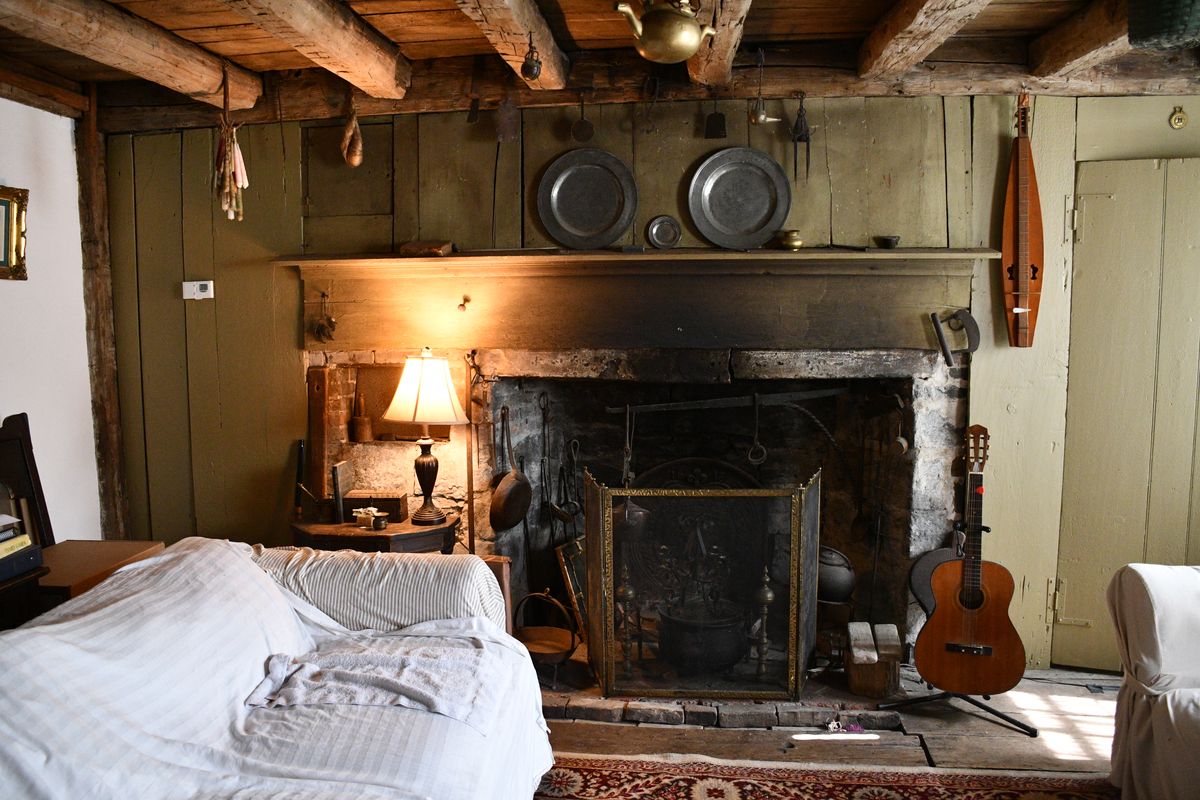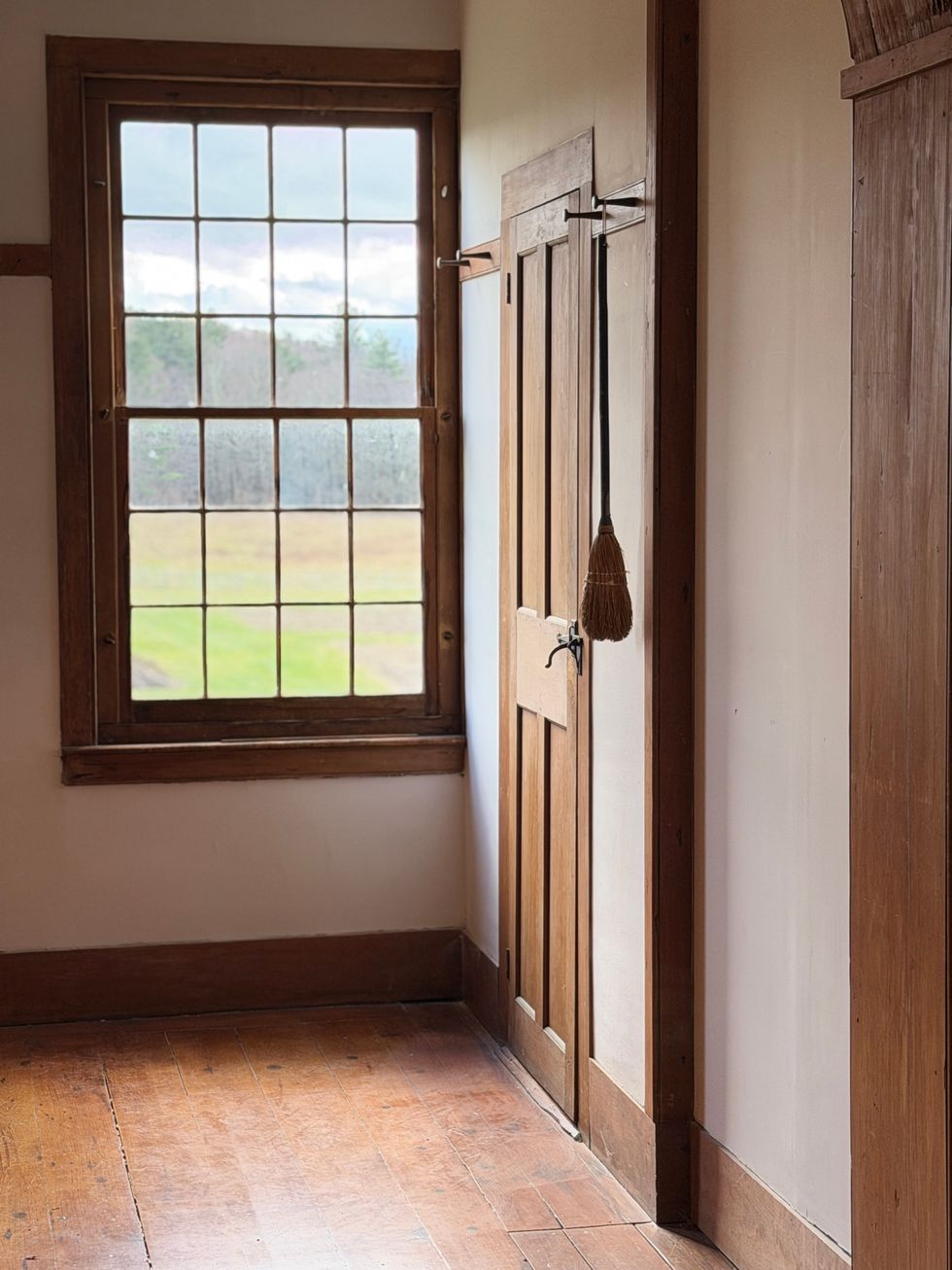Centuries-old surprise found in Kent home

The interior of the centuries-old home in South Kent.
Kathryn Boughton

The interior of the centuries-old home in South Kent.
KENT — Douglas and Chris Branson, owners of an old house located on the southeast corner of Camp Flats and South Kent Road, have uncovered a fascinating reminder of the building’s former life while making repairs to the mid-18th century building.
The house, originally constructed circa 1740 by John Hopson was doubled in size around 1780 when an addition was constructed. The earliest portion of the house, remarkably unchanged by nearly 300 years of occupation, remains intact, but the later addition suffered a significant blow in December 2023 when a winter gale sent a massive tree toppling onto it. “The whole house shook,” Douglas Branson said last week.
One front corner of the building was crushed under the tree and now, 17 months later, restoration work has begun. As workers cleared away the damaged portion of the house, removal of a ceiling suddenly revealed an old sign painted on what was once exterior clapboards.
The sign announced that it was the CW Page Store, which sold “Groceries, Good Things to Eat.”
The Bransons already knew some of the history of the property. They knew it had been a 140-acre farm where cattle and pigs were raised—indeed, the section of town where it lies is known as Pigtail Corners. They believed that a portion of it was once used as a post office. They knew that it had been a home to artists: Hugh Tyler who lived there in the mid-1900s and later Ms. Branson’s father, Larry Coultrip.
They inherited the property from Coultrip upon his death in 1998 and honored his desire that the building be preserved in as original a condition as possible. But they never suspected its mercantile background.
So, who was C.W. Page? It is probable that the merchant was Clark Page, both a son and a father to men named Walter Page. Page, variously described in census records as a blacksmith and farmer, was born in 1826 and died in 1897. The inventory of his estate reports the monetary value of “old store merchandise” and the sale of a store building for $850. His land was divided up among his heirs with his wife, Hellen, receiving much real estate.
Was the house on the corner where he had his store? It cannot be said with certainty. In 1897, six years after Clark Page’s death, Francis Atwater wrote in the History of Kent, Connecticut that one Fred Chase had become a wealthy businessman after buying “the small and ancient grocery store of this place,” a building that had passed through the hands of William Geer, Edward Dakins and a man named Segar. “It was an old stand, but it remained for Chase to make it a noteworthy establishment,” Atwater wrote.
Chase quickly built on his success, moving his store close to the railroad station and building a new dwelling house. Atwater writes, “South [of Chase’s property] is a feed store, it being the remodeled building formerly occupied by the small grocery.”
“The four houses in the immediate vicinity of the station are those of Walter Page [Clark Page’s son], VanNess Case, Miss Emiline Fanton and John Burkhardt. All are farmers and Mr. Page runs a distillery and cider mill,” Atwater concludes.
Did the Page family go back into the retail business and start their grocery store once more? We don’t know. What is clear is that a photo of the house taken in 1903, before a porch was added to the front, does not show the sign painted on the front. Walter Page became South Kent postmaster in 1915 and during his tenancy Larry Coultrip removed what he believed to be post office boxes from the porch addition.
The Bransons are interested in preserving the sign, but the work would not be covered by insurance. They have been exploring various funding options, including the Historic Homes Rehabilitation Tax Credit. Unfortunately, the property does not have either state or national register designation.
“Our goal is to preserve it,” said Douglas Branson. “We are hoping to share this amazing discovery as it is part of the history of the area and to see if there is any interest in a private party or historic entity helping preserve the store sign. We feel it would be a shame to cover it back up.”
Sharon Center School
SHARON — A Sharon Center School staff member discovered a “facsimile firearm” behind a file cabinet around 2 p.m. on Wednesday, Dec. 10, prompting an immediate response from State Police and a same-day notification to parents, according to Region One Superintendent Melony Brady-Shanley.
Brady-Shanley said in an email to families that, upon the item’s discovery, “The State Police were immediately notified and responded to the building.”
A canine team was brought in to sweep the building to confirm no additional items were present, “and the building has been fully cleared. The State Police consider this an isolated incident and not criminal in nature,” Brady-Shanley stated.
State Police explained, “Troopers from Troop B - North Canaan were dispatched to the Sharon Center School for reports of a firearm located in a closet. The firearm was determined to be a non-firing, replica firearm... There was no threat to the school or the public.”
Brady-Shanley emphasized “the safety and well-being of our students and staff remain our highest priority at all times. We will continue to follow and strengthen our safety protocols to ensure that our schools remain secure, supportive environments for learning.”
The Stone Round Barn at Hancock Shaker Village.
My husband Tom, our friend Jim Jasper and I spent the day at Hancock Shaker Village in Pittsfield, Massachusetts. A cold, blustery wind shook the limbs of an ancient apple tree still clinging to golden fruit. Spitting sleet drove us inside for warmth, and the lusty smells of manure from the goats, sheep, pigs and chickens in the Stone Round Barn filled our senses. We traveled back in time down sparse hallways lined with endless peg racks. The winter light was slightly crooked through the panes of old glass. The quiet life of the Shakers is preserved simply.

Originally founded in England, the Shakers brought their communal religious society to the New World 250 years ago. They sought the perfection of heaven on earth through their values of equality and pacifism. They followed strict protocols of behavior and belief. They were celibate and never married, yet they loved singing and ecstatic dancing, or “shaking,” and often adopted orphans. To achieve their millennialist goal of transcendental rapture, we learned, even their bedclothes had to conform: One must sleep in a bed painted deep green with blue and white coverings.
Shakers believed in gender and racial equality and anointed their visionary founding leader, Mother Ann Lee, an illiterate yet wise woman, as the Second Coming. They embraced sustainability and created practical designs of great utility and beauty, such as the mail-order seed packet, the wood stove, the circular saw, the metal pen, the flat broom and wooden clothespins.
Burning coal smelled acrid as the blacksmith fired up his stove to heat the metal rod he was transforming into a hook. Hammer on anvil is an ancient sound. My husband has blacksmithing skills and once made the strap hinges and thumb latches for a friend’s home.
Shaker chairs and rockers are still made today in the woodworker’s shop. They are well made and functional, with woven cloth or rush seats. In the communal living space, or Brick Dwelling, chairs hang from the Shaker pegs that run the length of the hallways, which once housed more than 100 Shakers.

In 1826, the 95-foot Round Stone Barn was built of limestone quarried from the land of the 3,000-acre Hancock Shaker Village. Its unique design allowed a continuous workflow. Fifty cows could stand in a circle facing one another and be fed more easily. Manure could be shoveled into a pit below and removed by wagon and there was more light and better ventilation.
Shakers called us the “people of the world” and referred to their farm as the City of Peace. We take lessons away with us, yearning somehow for their simplicity and close relationship to nature. One Shaker said, “There’s as much reverence in pulling an onion as there is in singing hallelujah.”
A sense of calm came over me as I looked across the fields to the hills in the distance. A woman like me once stood between these long rows of herbs — summer savory, sage, sweet marjoram and thyme — leaned on her shovel brushing her hair back from her eyes, watching gray snow clouds roll down the Berkshires.
More information at hancockshakervillage.org

Exterior of Lakeville Books & Stationery in Great Barrington.
Fresh off the successful opening of Lakeville Books & Stationery in April 2025, Lakeville residents Darryl and Anne Peck have expanded their business by opening their second store in the former Bookloft space at 63 State St. (Route 7) in Great Barrington.
“We have been part of the community since 1990,” said Darryl Peck. “The addition of Great Barrington, a town I have been visiting since I was a kid, is special. And obviously we are thrilled to ensure that Great Barrington once again has a new bookstore.”
The second Lakeville Books & Stationery is slightly larger than the first store. It offers more than 10,000 books and follows the same model: a general-interest store with a curated mix of current bestsellers, children’s and young readers’ sections; and robust collections for adults ranging from arts and architecture, cooking and gardening, and home design to literature and memoirs. Anne reads more than 150 new titles every year (as many as a Booker Prize judge) and is a great resource to help customers find the perfect pick.
A real-time inventory system helps the store track what’s on hand, and staff can order items that aren’t currently available. There is also a selection of writing and paper goods, including notecards, journals, pens and notebooks, as well as art supplies, board games, jigsaw puzzles and more. The owners scour the stationery trade shows twice a year and, Darryl says, “like to tailor what we offer to suit the interest of our customers in each market.”
The Pecks know what it takes to run a successful local enterprise. Darryl has a 53-year background in retail and has launched several successful businesses. He and Anne owned and operated a bookstore on St. Simons Island, Georgia, from 2019 to 2025. They are tapping into their local roots with both stores. They raised their family in Sharon, and their daughter Alice, a native of the Northwest Corner, manages the Lakeville store.

The family values the role that a retail store plays as a supporting partner in the community, and they prioritize great management in both locations, hiring and training talent from local communities. Their 10 team members across both stores are from the area, and two of the Great Barrington employees previously worked at Bookloft.
Darryl and Anne’s attention to customer service is everywhere apparent and adds to the enjoyable and irreplaceable in-store shopping experience. The books are in pristine condition, eliminating the risk of damage that sometimes occurs during shipping. This is especially important for books that will live on people’s shelves and coffee tables for years.
Darryl says, “People love the in-store discovery — you find books you didn’t know existed, which is very difficult to do on a website. Also, many customers depend on our recommendations when visiting. There is a saying about bookstores versus online ordering: We may not have exactly what you were looking for, but we have what you want.”
Lakeville Books & Stationery’s Great Barrington store is open 7 days a week, Monday-Saturday, 10 a.m. to 6 p.m., and Sunday, 11 a.m. to 5 p.m. Parking is available in the lot behind the building and in the parking lot behind the firehouse. The entrance to the store is accessible from the store parking lot.
For more information, go to lakevillebooks.com., and sign-up for the Lakeville Books newsletter.
Richard Feiner and Annette Stover have worked and taught in the arts, communications, and philanthropy in Berlin, Paris, Tokyo and New York. Passionate supporters of the arts, they live in Salisbury and Greenwich Village.